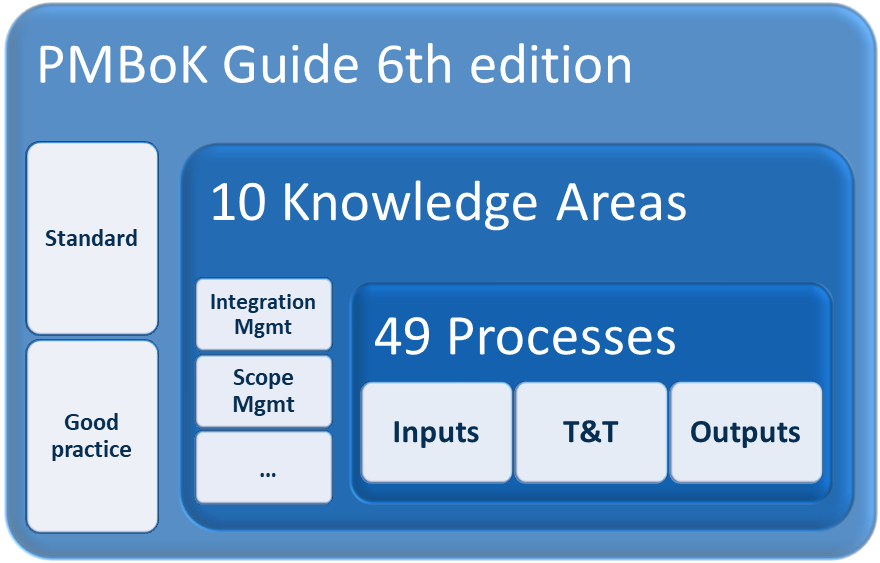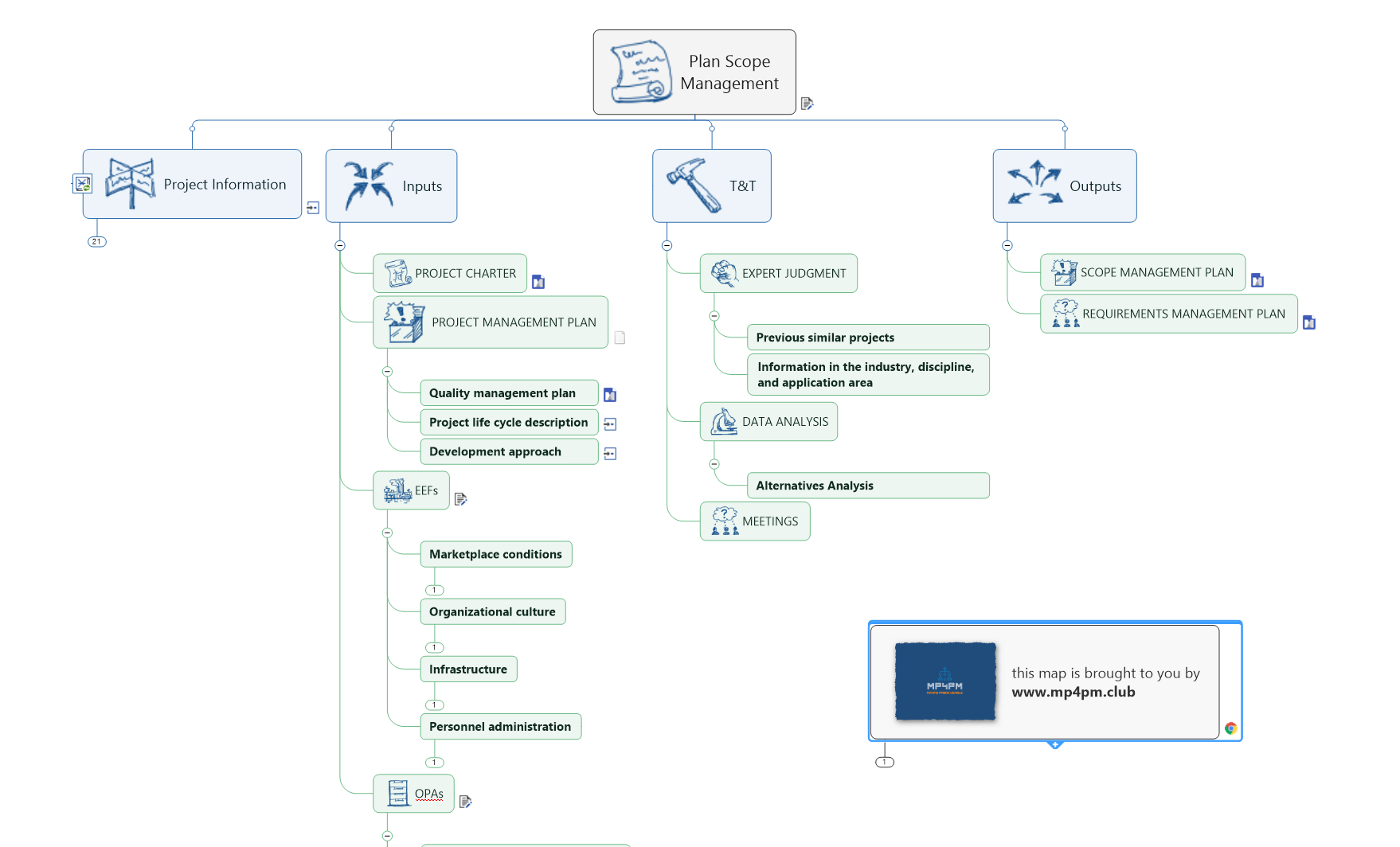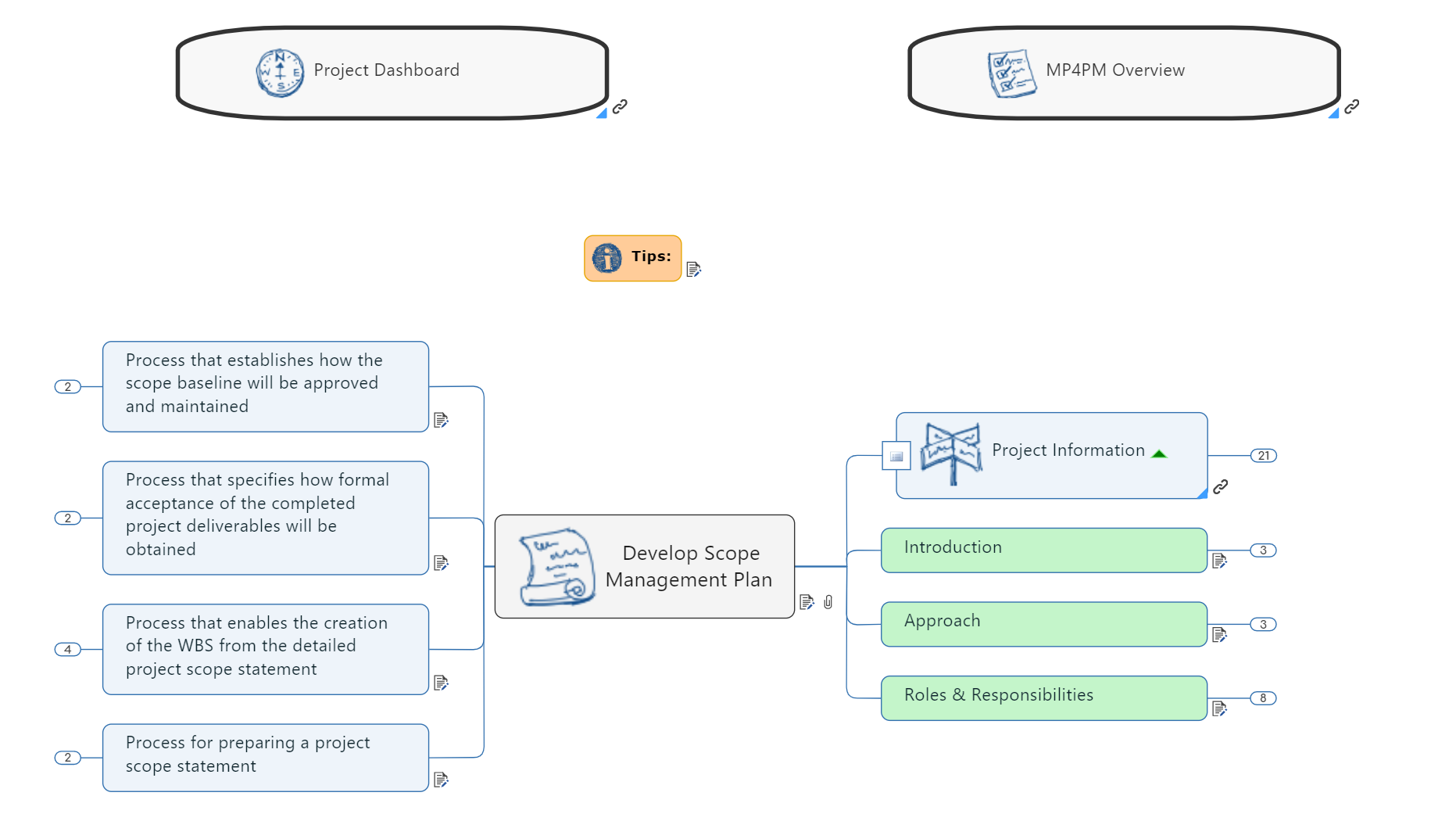By: Markus Kopko, Creator of MP4PM
Welcome back! In the first article of this multi-part series, which deals in depth with the application of mind mapping in project management, I have given you a short introduction to the topic and an overview of the benefits.
My online project “MP4PM – MindManager for Project Management” is based on the structure of A Guide to the Project Management Body of Knowledge (PMBOK® Guide) which is published by the “Project Management Institute (PMI). It consists of ten so-called Knowledge Areas (such as Scope Management; Cost Management; Stakeholder Management etc.) and a total of 49 project management processes, which are distributed among these 10 KAs.
Each of the 49 processes, in turn, contains ITTOS (Inputs, Tools, Techniques, and Outputs). In total, there are several hundred ITTOs, and my conviction is that mind mapping can be a helpful support for almost any of these items.

Because of its very advanced and often project-related features and functions, MindManager is my absolute favorite tool, and the catalyst behind my work with “MP4PM”.
In this – and upcoming – article(s) I will introduce each of the ten knowledge areas (KAs) in detail, and show you examples of the processes I’ve been able to create for each using mind maps and the MP4PM framework.
If you’re familiar with the PMBOK® Guide, you’ll know that the first KA is typically “Integration Management”. We’re going to do things a bit differently and start with “Scope Management” instead, and loop back to “Integration Management” at the end of the series.
Knowledge Area #1: Scope Management
Project Scope Management refers to processes that ensure that the scope includes all the work required, and only the work required, to complete the project successfully.
Managing project scope primarily involves defining and controlling what is and is not included in the project.
To aid with this process, there are six Project Scope management processes that you should be aware of. These include:
- Plan Scope Management: The process of creating a scope management plan that documents how the project and product scope will be defined, validated, and controlled.
- Collect Requirement: The process of determining, documenting, and managing stakeholder needs and requirements to meet project objectives.
- Define Scope: The process of developing a detailed description of the project and product.
- Create Work Breakdown Structure (WBS): The process of subdividing project deliverables and project work into smaller, more manageable components.
- Validate Scope—The process of formalizing acceptance of the completed project deliverables.
- Control Scope—The process of monitoring the status of the project and product scope, and managing changes to the scope baseline.
Project Scope Management is concerned with defining all the work of the project and only the work needed to successfully achieve the project goals.
These processes are highly interactive. They define and control what is and what is not part of the project. Each process occurs at least once—and often many times—throughout the project’s life.
Project Scope Management encompasses both product scope and project scope.
Product scope concerns the characteristics of the product, service, or result of the project. It is measured against the product requirements to determine successful completion or fulfillment.
Project scope involves managing the work of the project and only the work of the project. Project scope is measured against the project management plan. The scope baseline is made up of the project scope statement, the WBS, and the WBS dictionary.
The mind mapping technique, and mind mapping software, is especially helpful in the planning phase of a project, and these corresponding processes. To illustrate this, we’ll take a closer look at the purpose of a Scope Management plan, and how to prepare one using mind mapping software.
The purpose of the Project Scope Management Plan
The Scope Management Plan is a continuous document that enables the following:
1. Provides structure
The Scope Management Plan is developed to create a structure within which the project scope can develop until successful completion. It is a collection of documents that serve as a reference point for all project execution, monitoring and control, and project or phase completion regarding project scope.
2. Provides documentation
A truly successful project requires a documented Project Scope Management Plan. Documents provide a historical overview and the reasons why decisions were made the way they were made. A Scope Management Plan must include documentation of the assumptions and constraints that influence the development of the project scope management plan.
3. Enables communication
Project Scope Management Plans are documents that provide information and explanations as to why project decisions have been made as documented. The Project Scope Management Plan serves as a source of communication between stakeholders, the project team, and management to communicate how the project scope is managed.
4. Specifies provisions of the scope baseline
A Project Scope Management Plan contains the scope baseline (and is part of the overall project management plan). As the project progresses towards completion, management, stakeholders, and the project manager can use the Project Scope Management Plan to see what has been predicted in terms of scope, and then compare how these predictions will compare with actual project progress.
Preparing to develop the Project Scope Management Plan
To develop the project scope management plan effectively, the project manager and the participants must agree on the project goals and deliverables. To achieve this agreement, the project manager works with stakeholders to achieve a balance between expectations and objectives.
MP4PM provides a detailed process map (ITTOs) for any of the 49 project management processes, including the Project Scope management stage. As screenshot of this process map is shown below.

Project managers must be able to negotiate the best solution to a problem or opportunity. The project scope management plan is drawn up based on the project management methodology chosen or specified, the type of work to be carried out, and the overall scope of the project.
To develop the Project Scope Management Plan, you need the project charter, and the different components of the project management plan, including enterprise environmental factors (EEFs) and organizational process assets (OPAs).
Because the development of the Project Scope Management Plan is an iterative process, you will not know everything when you start creating it. Outputs from other processes require you to return to your Project Scope Management plan and update it accordingly.
Each project is different, even when it comes to planning. But a project team will continue with the planning phase until it has a thorough understanding of the project work to be done and a clear understanding of what to do and how to achieve the project objectives.
All inputs to the Project Scope Management Plan should be available to the project manager, as he or she may need to rely on this information for further planning.
The tools and techniques for developing the Project Management Plan are merely technical assessment and moderation techniques. Expert judgment is not just the job of the project manager but involves several key stakeholders, including:
- project leader
- project team
- management
This team works together to complete the Project Scope Management Plan.
Moderation techniques require the project manager to manage and control the planning meetings. They use various methods such as brainstorming, focus groups, or interviews to ensure stakeholder participation. Mind maps are an excellent tool here.
Other standard interpersonal and data-related techniques include checklists, facilitation, conflict resolution, and proper meeting management to help participants reach consensus on what should be included in the Project Scope Management Plan and what not.
Examples of a Project Scope Management Plan
Projects are unique. The PMBoK Guide give us a general guidance on which topics should be documented in a professional Project Scope Management Plan, but some may require additional information, and some projects may include the same topics, processes, or data.
That means you will need to tailor the process and the template/documentation to fit your organization‘s and project‘s specific needs. That concept of tailoring and customizing the processes and the templates/documentation will follow us through all of the PMBoK Guide processes.
With MP4PM we not only provide you the Process Maps and the supporting development maps, but also ready-to-use MS Office templates that are 100% aligned to the PMBoK Guide.
This way you can create and organize your project deliverables faster and more effectively than ever.
Here‘s overview of our Scope Management Plan Template, which is strictly aligned to the corresponding map:
Creating a customized Project Scope Management Plan with MP4PM
Here’s a step-by-step process on how to develop your own Project Scope Management Plan, based on my MP4PM Template and Toolkit package.
Click on the below picture to be directed to the interactive, online version of this map:
 Download the corresponding “MP4PM Template and Toolkit“ by clicking here.
Download the corresponding “MP4PM Template and Toolkit“ by clicking here.
Then, follow these steps?
- Extract the archive to a folder and make a copy of that folder.
- Name and store them in a way you can easily re-find them.
- ?Make yourself familiar with the template by reading through its sections. I would strongly recommend starting with the mind map. If you do not use a mind mapping software (like MindManager), just use the HTML version of the map in your web browser.
- Meet with your project stakeholders. Use the tools and techniques included in this toolkit to collect the needed information regarding the scope management plan. Write down a high-level description of how the project team does the related work on the project.
- You may need to hold several meetings, brainstorming sessions, or focus groups with different groups of stakeholders. In each of these sessions, document the outcomes using your platform of choice. Again, mind mapping software is an ideal solution for this step.
- Structure and re-organize the collected information based on your gained insights after each meeting and event. If you’ve collected this information using MindManager, you can easily drag and drop information around your map to organize and categorize it. Use features like tagging, filtering, linking, and attachments to expand and make sense of your project information.
- While writing and discussing first and second points, you will discover a lot of inconsistencies. Your stakeholders will ask a lot of questions. Usually, it will be points where responsibility goes from one person to another. Those are the pain points of your project. Clarifying them together with the stakeholders is the priority.
- As soon as you feel good about the collected information regarding your project scope management plan transfer, prepare your plan for presentation to your project sponsor.
- Present that first draft to your sponsor and the project management team and get their input. Update and enhance the draft based on their feedback.
- Hold another meeting with all of the key stakeholders, present the current version of the draft to them and get their feedback. It is mandatory for project success that all of the key stakeholders are committed to the Project Scope Management Plan (not only the sponsor).
- Based on their feedback, make final adjustments and finalize your Project Scope Management Plan.
- Get sign-off for the project scope management plan by your sponsor or any other authority who is in charge.
- Communicate the signed version to all the key stakeholders.
- Maintain, update, improve. Once you have a framework of your Project Scope Management Plan, you can adopt it to any other future project. You may adjust that step-by-step process based on your own and/or organizational expertise, experiences and needs.
Thank you for reading thus far!
See you next time when we dive deep into the next Knowledge Area – Project Schedule Management.
– Markus




